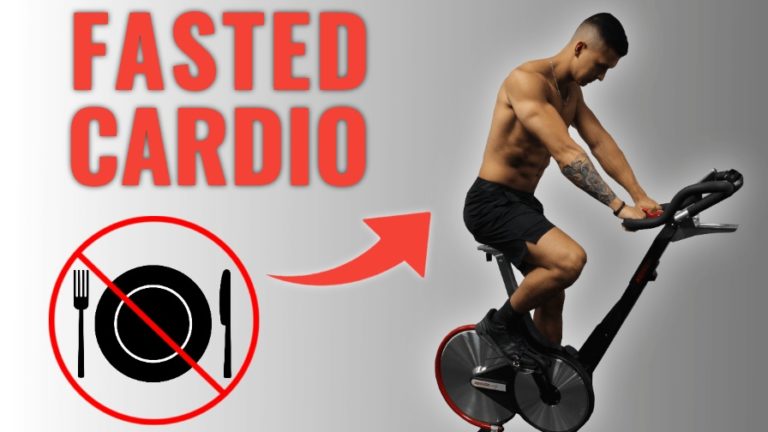The Concept of Cardio on an Empty Stomach: Separating Fact from Fiction
Cardio with an empty stomach has gained significant attention in recent years, with proponents advocating for its potential benefits, such as increased fat burning and weight loss. The idea stems from the concept of fasted cardio, which involves performing aerobic exercises in a fasted state, typically in the morning before breakfast. This practice is believed to force the body to utilize stored fat as an energy source, rather than relying on recently consumed calories.
Despite the growing interest in cardio with an empty stomach, it is essential to separate fact from fiction. While some studies suggest that fasted cardio may have a slight edge in promoting fat oxidation compared to traditional cardio, the overall impact on weight loss and body composition remains a topic of debate among researchers.
One common misconception is that cardio with an empty stomach leads to more significant weight loss due to an increased metabolic rate. However, research has shown that fasted cardio does not significantly enhance metabolism or result in greater caloric expenditure compared to traditional cardio. Moreover, engaging in high-intensity exercise on an empty stomach may lead to decreased performance and increased muscle breakdown, which can hinder overall fitness goals.
Despite these concerns, cardio with an empty stomach can still be an effective strategy for certain individuals, particularly those looking to improve fat oxidation and insulin sensitivity. By understanding the potential benefits and limitations of this practice, individuals can make informed decisions about incorporating cardio with an empty stomach into their fitness routines.
How to Effectively Implement Cardio on an Empty Stomach
To safely and effectively incorporate cardio with an empty stomach into your fitness regimen, consider the following steps:
- Gradual adaptation: Begin by performing light-intensity cardio exercises, such as walking or cycling, on an empty stomach for short durations. Gradually increase the intensity and duration as your body adapts to the new exercise routine.
- Timing: Schedule your fasted cardio sessions in the morning, as this is when your body is most likely to be in a fasted state. Aim to complete your workout within 30 to 60 minutes after waking up to maximize the benefits of fasted cardio.
- Hydration: Ensure that you are well-hydrated before, during, and after your fasted cardio session. Drinking water can help maintain energy levels, prevent dehydration, and support overall exercise performance.
- Intensity and duration: Adjust the intensity and duration of your fasted cardio workouts based on your fitness level and goals. For beginners, start with low-intensity, shorter sessions and progress to higher-intensity, longer workouts as your body adapts.
- Monitoring and adjustments: Pay close attention to your body’s response to fasted cardio, including changes in energy levels, performance, and recovery. Make adjustments to your workout routine as needed to ensure that it remains safe, effective, and sustainable.
By following these guidelines, you can successfully implement cardio with an empty stomach into your fitness routine, taking advantage of its potential benefits while minimizing the risks and challenges associated with this practice.
Understanding Your Body: Assessing the Impact of Fasted Cardio
Fasted cardio can have various effects on an individual’s energy levels, performance, and recovery. It is crucial to monitor your body’s response to fasted cardio to ensure that it remains a safe and effective addition to your fitness routine. Here are some factors to consider when assessing the impact of fasted cardio:
- Energy levels: Observe how your energy levels change during and after fasted cardio sessions. Some individuals may experience a dip in energy, while others may feel more alert and focused. Adjusting the intensity and duration of your workouts can help manage energy levels and maintain optimal performance.
- Performance: Monitor your performance during fasted cardio sessions, taking note of any changes in speed, endurance, or strength. If you notice a significant decline in performance, consider incorporating a small pre-workout meal or modifying the intensity and duration of your workouts to better suit your body’s needs.
- Recovery: Pay attention to your recovery process after fasted cardio sessions. Fasted cardio may lead to increased muscle breakdown and delayed recovery in some individuals. Ensuring proper nutrition, hydration, and rest can help support muscle repair and growth, as well as overall exercise recovery.
By closely monitoring your body’s response to fasted cardio, you can make informed decisions about adjusting your workout routine and nutritional strategies to better support your fitness goals and overall well-being.
Fasted Cardio and Weight Loss: Separating Myths from Reality
The relationship between fasted cardio and weight loss has been a subject of debate among fitness enthusiasts and researchers alike. While some claim that fasted cardio is a highly effective weight loss strategy, others argue that it offers no significant advantages over traditional cardio. Here, we examine the facts and misconceptions surrounding fasted cardio and weight loss:
- Increased fat oxidation: Some studies suggest that fasted cardio may result in slightly higher fat oxidation rates compared to traditional cardio. However, this does not necessarily translate to greater weight loss or improved body composition.
- Metabolic rate: Contrary to popular belief, fasted cardio does not significantly enhance metabolism or result in greater caloric expenditure compared to traditional cardio. The overall impact of fasted cardio on weight loss is minimal when considering energy balance and total daily caloric intake.
- Muscle preservation: Performing cardio with an empty stomach may increase the risk of muscle breakdown and negatively affect muscle growth and repair. Proper nutrition, including pre- and post-workout meals, is crucial for maintaining muscle mass during weight loss and supporting overall exercise recovery.
- Individual differences: The effectiveness of fasted cardio for weight loss can vary significantly between individuals, depending on factors such as genetics, lifestyle, and personal fitness goals. It is essential to consider individual differences when evaluating the potential benefits and drawbacks of fasted cardio for weight loss.
In conclusion, while fasted cardio may have a slight edge in promoting fat oxidation, its overall impact on weight loss and body composition remains a topic of debate. A well-rounded fitness routine, incorporating a balanced diet, regular exercise, and adequate rest, is crucial for achieving and maintaining a healthy weight.
The Role of Nutrition in Fasted Cardio
Proper nutrition plays a vital role in supporting fasted cardio and maximizing its potential benefits. Here, we discuss recommendations for pre- and post-workout meals and hydration to optimize your fasted cardio routine:
Pre-workout nutrition
Since fasted cardio is performed in a fasted state, it is essential to consume a nutritious meal a few hours before bedtime to provide your body with the necessary energy and nutrients for exercise. Aim for a balanced meal containing carbohydrates, proteins, and healthy fats. For example:
- Grilled chicken with quinoa and steamed vegetables
- Whole grain pasta with turkey meatballs and marinara sauce
- Salmon with sweet potato and mixed greens salad
Post-workout nutrition
After completing your fasted cardio session, it is crucial to refuel your body with a nutrient-dense meal to support muscle repair, growth, and overall recovery. Aim to consume a meal within 60 minutes of your workout, focusing on the following macronutrients:
- Carbohydrates: Replenish glycogen stores and support muscle recovery with complex carbohydrates, such as whole grains, fruits, and vegetables.
- Protein: Promote muscle growth and repair by consuming high-quality protein sources, such as lean meats, dairy products, eggs, or plant-based protein alternatives.
- Healthy fats: Support hormonal balance and overall health by incorporating healthy fats, such as avocados, nuts, seeds, or olive oil, into your post-workout meals.
Hydration
Staying well-hydrated is essential for optimal exercise performance, recovery, and overall health. Aim to drink at least 8 to 10 cups of water per day, increasing your intake as needed based on your activity level, climate, and individual needs. Consider incorporating hydrating beverages, such as herbal teas or infused water, into your daily routine to support your hydration goals.
By following these nutritional recommendations, you can optimize your body’s response to fasted cardio and ensure that you are providing the necessary energy, nutrients, and hydration to support your fitness goals.
Fasted Cardio vs. Traditional Cardio: A Comparative Analysis
Both fasted cardio and traditional cardio offer unique advantages and disadvantages, making it essential to understand the differences between these two approaches to determine which is best suited for your individual fitness goals and lifestyle. Here, we compare and contrast fasted cardio with traditional cardio, highlighting the unique advantages and disadvantages of each approach:
Fasted cardio advantages
- Increased fat oxidation: Some studies suggest that fasted cardio may result in slightly higher fat oxidation rates compared to traditional cardio. However, this does not necessarily translate to greater weight loss or improved body composition.
- Potential for improved insulin sensitivity: Engaging in regular fasted cardio sessions may help improve insulin sensitivity, which can support overall health and well-being.
- Flexibility: Fasted cardio can be performed at any time of day, offering flexibility for those with busy schedules or limited time for exercise.
Fasted cardio disadvantages
- Decreased performance: Performing cardio with an empty stomach may lead to decreased performance, particularly during high-intensity workouts or when engaging in prolonged exercise sessions.
- Increased muscle breakdown: Fasted cardio may increase the risk of muscle breakdown, negatively affecting muscle growth and repair.
- Potential for low energy levels: Some individuals may experience low energy levels during fasted cardio sessions, which can negatively impact exercise performance and enjoyment.
Traditional cardio advantages
- Improved exercise performance: Performing cardio with adequate fuel in your system can lead to improved exercise performance, particularly during high-intensity workouts or prolonged exercise sessions.
- Reduced muscle breakdown: Traditional cardio may result in less muscle breakdown compared to fasted cardio, supporting overall muscle growth and repair.
- Enhanced enjoyment: Engaging in cardio with the necessary energy and nutrients can lead to a more enjoyable exercise experience, increasing the likelihood of long-term adherence and success.
Traditional cardio disadvantages
- Limited fat oxidation: Traditional cardio may result in slightly lower fat oxidation rates compared to fasted cardio, although this does not necessarily translate to reduced weight loss or improved body composition.
- Reduced flexibility: Traditional cardio typically requires consuming a pre-workout meal, which can limit flexibility for those with busy schedules or limited time for exercise.
Ultimately, the choice between fasted cardio and traditional cardio depends on your individual fitness goals, abilities, and lifestyle. By understanding the unique advantages and disadvantages of each approach, you can make an informed decision about which method best supports your health and wellness journey.
Designing a Personalized Fasted Cardio Program
Creating a tailored fasted cardio program that suits your individual fitness goals, abilities, and lifestyle is crucial for ensuring long-term adherence and success. Here, we guide you through the process of designing a personalized fasted cardio program that meets your unique needs:
Step 1: Define your fitness goals
Begin by identifying your primary fitness goals, such as weight loss, improved cardiovascular health, or enhanced athletic performance. Clearly defining your objectives will help you determine the most appropriate fasted cardio approach and ensure that your program aligns with your overall health and wellness journey.
Step 2: Assess your abilities and limitations
Consider your current fitness level, exercise history, and any potential limitations or injuries that may impact your ability to perform fasted cardio safely and effectively. Adjust your program accordingly, selecting exercises and intensities that align with your abilities and support your fitness goals.
Step 3: Choose the appropriate fasted cardio approach
Based on your fitness goals and abilities, select the most suitable fasted cardio approach, such as low-intensity steady-state cardio, high-intensity interval training, or a combination of both. Factor in your schedule and lifestyle to determine the most convenient time to perform fasted cardio, ensuring that you can consistently adhere to your program.
Step 4: Determine the duration and frequency of your fasted cardio sessions
Establish the duration and frequency of your fasted cardio sessions, taking into account your fitness level, exercise history, and overall health. Gradually increase the duration and intensity of your workouts as your body adapts to the demands of fasted cardio, ensuring that you progress at a safe and sustainable pace.
Step 5: Monitor your body’s response
Regularly assess your body’s response to fasted cardio, paying close attention to changes in energy levels, performance, and recovery. Adjust your program as needed, making modifications to the duration, intensity, or frequency of your workouts to optimize your results and ensure long-term adherence and success.
By following these steps, you can design a personalized fasted cardio program that supports your fitness goals, abilities, and lifestyle, ultimately unleashing the power of cardio with an empty stomach and maximizing your health and wellness potential.
Overcoming Challenges and Maintaining Motivation in Fasted Cardio
Embarking on a fasted cardio routine can present unique challenges, such as low energy levels and decreased motivation. To ensure long-term adherence and success, consider the following practical tips and strategies for overcoming these common obstacles:
1. Prioritize hydration
Staying well-hydrated is essential for maintaining energy levels and supporting overall health during fasted cardio. Aim to drink at least 8 to 10 cups of water per day, increasing your intake as needed based on your activity level, climate, and individual needs. Consuming hydrating beverages, such as herbal teas or infused water, can also help support your hydration goals.
2. Fuel your body with nutrient-dense foods
Proper nutrition plays a vital role in supporting fasted cardio. Focus on consuming nutrient-dense foods, such as whole grains, lean proteins, fruits, vegetables, and healthy fats, to provide your body with the necessary energy and nutrients for exercise. Avoid processed and high-sugar foods, which can lead to energy crashes and negatively impact your overall health and well-being.
3. Gradually increase the intensity and duration of your workouts
To minimize the risk of injury and fatigue, gradually increase the intensity and duration of your fasted cardio sessions. This approach allows your body to adapt to the demands of fasted cardio, ensuring that you can maintain long-term adherence and success.
4. Incorporate variety into your exercise routine
Mixing up your fasted cardio routine by incorporating various exercises and activities can help prevent boredom and maintain motivation. Consider engaging in activities that you enjoy, such as swimming, cycling, or dancing, to keep your workouts fresh and exciting.
5. Establish a support system
Sharing your fasted cardio journey with friends, family members, or workout partners can help maintain motivation and accountability. Seek out individuals who share your fitness goals and values, and consider joining online communities or forums to connect with like-minded individuals and gain valuable insights and support.
6. Set realistic goals and track your progress
Setting realistic fitness goals and tracking your progress can help maintain motivation and provide a sense of accomplishment. Regularly assess your body’s response to fasted cardio, making modifications to your program as needed to optimize your results and ensure long-term adherence and success.
By following these practical tips and strategies, you can overcome common challenges in fasted cardio, maintain motivation, and ensure long-term adherence and success in your health and wellness journey.









